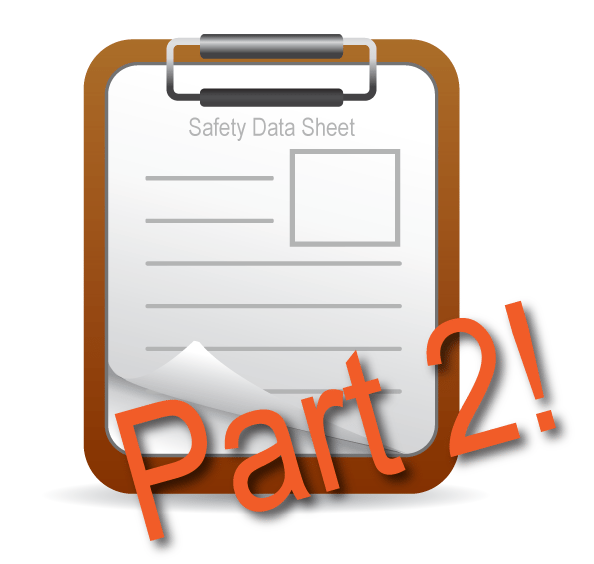
We wrote on Tuesday about the new regulations concerning OSHA Safety Data Sheets. To refresh, the new regulations require a 16 section format for Safety Data Sheets. This format is modeled after ANSI. The order and placement of each section is not allowed to be altered. We covered sections one through six last time; today we will cover seven through eleven.
7. Handling and Storage
The information required in section seven deals with the safe handling and storage of chemicals. This section needs to include guidelines for safe handling of chemicals including listing incompatible chemicals, minimizing the release of the chemical into the environment, and providing basic hygiene practices to be followed in chemical work areas.
8. Exposure Controls/Personal Protection
In section eight you need to include exposure limits (OSHA Permissible Exposure Limits (PELs), American Conference of Governmental Industrial Hygienists (ACGIH) Threshold Limit Values (TLVs), and any other exposure limit used or recommended), engineering controls, and personal protective measures to be taken to minimize worker exposure.
9. Physical and Chemical Properties
Section nine is where physical and chemical properties associated with the substance or mixture need to be denoted. At a minimum, the information listed in this section needs to include:
- Appearance (physical state, color, etc.);
- Upper/lower flammability or explosive limits;
- Odor;
- Vapor pressure;
- Odor threshold;
- Vapor density;
- pH;
- Relative density;
- Melting point/freezing point;
- Solubility(ies);
- Initial boiling point and boiling range;
- Flash point;
- Evaporation rate;
- Flammability (solid, gas);
- Upper/lower flammability or explosive limits;
- Vapor pressure;
- Vapor density;
- Relative density;
- Solubility(ies);
- Partition coefficient: n-octanol/water;
- Auto-ignition temperature;
- Decomposition temperature; and
- Viscosity.
That said, not every item on the list above will be relevant to or available for every substance or mixture. If that is the case manufacturers must make a note of the fact for that chemical property.
10. Stability and Reactivity
This section lists out the information concerning reactivity hazards and chemical stability information and is broken into three parts, reactivity, chemical stability, and other. These three parts require different information.
Reactivity: The reactivity part must include a description of specific test data for the chemical or chemicals. This data can be for a class or family of the chemical if such data adequately represent the anticipated hazard of the chemical(s).
Chemical stability: This section needs to indicate whether or not the chemical is stable or unstable under normal ambient temperature and conditions when stored or transferred. Additionally, it needs to include a description of any necessary stabilizers needed to maintain chemical stability and an indication of any potential safety issues that could occur it the product were to change in physical appearance.
Other: The “other” section needs to include information on the possibility of hazardous reactions, including a statement as to whether the chemical will react or polymerize, which could release excess pressure or heat, or create other hazardous conditions. Also, a description of the conditions under which hazardous reactions may occur must be included. This section is also where conditions that should be avoided, a list of incompatible materials, and a list of any known or anticipated hazardous decomposition products that could be produced because of use, storage, or heating need to be listed.
11. Toxicological Information
This section must include information that identifies toxicological and health effects or indicate that such data is not available. This information must include likely routs of exposure, description of all effects from short or long term exposure, numerical measures of toxicity, a description of the symptoms associated with exposure, and indication of whether the chemical is listed in the National Toxicology Program (NTP) Report on Carcinogens (latest edition) or has been found to be a potential carcinogen in the International Agency for Research on Cancer (IARC) Monographs (latest editions) or found to be a potential carcinogen by OSHA.
Keep checking the blog for part three (the final post), coming soon. For complete information visit the OSHA website here.
More News From Heritage
-
3/12/24
Equal Pay Day – Spotlighting Our Female Drivers
-
3/8/24
International Women’s Week Spotlight – Shannon Dippel
For International Women's Week, we're spotlighting some of the incredible women in the Heritage family. Our final spotlight is Shannon Dippel.
-
3/8/24
International Women’s Week Spotlight – Susan Adams
For International Women's Week, we're spotlighting some of the incredible women in the Heritage family. Our sixth spotlight is Susan Adams.
-
3/7/24
International Women’s Week Spotlight – Lea Wilson
For International Women's Week, we're spotlighting some of the incredible women in the Heritage family. Our fifth spotlight is Lea Wilson
-
3/7/24
International Women’s Week Spotlight – Melissa Fisk
For International Women's Week, we're spotlighting some of the incredible women in the Heritage family. Our fourth spotlight is Melissa Fisk.
-
3/6/24
International Women’s Week Spotlight – Taylor Harvey
For International Women's Week, we're spotlighting some of the incredible women in the Heritage family. Our third spotlight is Taylor Harvey
-
3/5/24
International Women’s Week Spotlight – Karen Esquivel
For International Women's Week, we're spotlighting some of the incredible women in the Heritage family. Our second spotlight is Karen Esquivel.
-
3/5/24
Heritage Environmental Services Announces HP Nanda as CEO; CEO Jeff Laborsky Transitions to Board of Directors
Heritage Environmental Services (“HES”) announced today that HP Nanda will join the organization as CEO.








